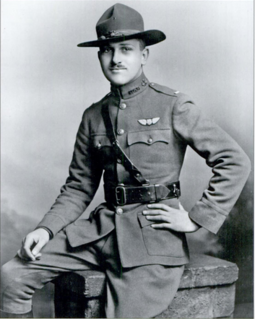Related Research Articles
This is a list of aviation-related events from 1917.
This is a list of aviation-related events from 1918:

World War I was the first major conflict involving the large-scale use of aircraft. Tethered observation balloons had already been employed in several wars, and would be used extensively for artillery spotting. Germany employed Zeppelins for reconnaissance over the North Sea and Baltic and also for strategic bombing raids over Britain and the Eastern Front.
John Inglis Gilmour, was a British flying ace of the First World War. He was the highest scoring Scotsman in the Royal Flying Corps, with 39 victories.

Rittmeister Karl Bolle, PlM, MMC, HOH, IC, was a fighter ace with 36 aerial victories during World War I. He became a Jagdstaffel commander during that war, and an advisor to the Luftwaffe during World War II.
Sergeant Christopher James Shannon was an English First World War flying ace credited with five aerial victories.
Sergeant Frank William Bell was an observer and air gunner in the Royal Air Force during World War I. He was a flying ace credited, together with his pilot, with six aerial victories.
Sergeant-Observer William James Middleton was a British World War I flying ace credited with six aerial victories.
Lieutenant Eric Walker was a British World War I flying ace credited with six aerial victories.
Second Lieutenant Frederick Charles Wilton was a South African World War I flying ace credited with six aerial victories.
Thomas Charles Richmond Baker, was an Australian soldier, aviator, and flying ace of the First World War. Born in Smithfield, South Australia, he was an active sportsman in his youth and developed a keen interest in aviation. He was employed as a clerk with the Bank of New South Wales, before he enlisted in the Australian Imperial Force in July 1915, for service in World War I. Posted to an artillery unit on the Western Front, he was awarded the Military Medal for carrying out numerous repairs on a communications line while subject to severe artillery fire. In June 1917, Baker was awarded a bar to his decoration for his part in quelling a fire in one of the artillery gun pits that was endangering approximately 300 rounds of shrapnel and high explosive.
John J. Cowell, was an Irish soldier, airman and flying ace of the First World War. He was credited with sixteen aerial victories; fifteen of these were gained as an observer/gunner and one as a pilot, before he was killed in action.

Roy Cecil Phillipps, MC & Bar, DFC was an Australian fighter ace of World War I. He achieved fifteen victories in aerial combat, four of them in a single action on 12 June 1918. A grazier between the wars, he joined the Royal Australian Air Force (RAAF) in 1940 and was killed in a plane crash the following year.

First Lieutenant Lloyd Andrews Hamilton was a World War I flying ace credited with ten aerial victories. During five months of 1918 he became an ace with the Royal Air Force (RAF) and then again with the United States Air Service (USAS). Hamilton Air Force Base is named after him.
Lieutenant Gavin Lynedoch Graham DFC, LdH, CdG was a South African World War I flying ace credited with thirteen confirmed aerial victories.
Second Lieutenant Francis James Ralph was a British World War I ace credited with 13 confirmed aerial victories over German fighter aircraft while flying as an aerial observer.
Lieutenant William Thomas Barnes was an English flying ace of World War I. He served as an observer/gunner in Bristol F.2 Fighters, gaining, in conjunction with his pilots, nine confirmed aerial victories over German Fokker D.VII fighter planes. Post-war he served in the Royal Irish Constabulary and was killed in the Kilmichael ambush of 28 November 1920.
Walter Naylor, & Bar was the leading observer ace of the Royal Naval Air Service, with 14 accredited victories. He flew as an enlisted observer/gunner in Airco DH.4 bombers in No. 5 Naval Squadron along the English Channel.
Captain John Stevenson Stubbs DFC AFC was an English First World War flying ace credited with 11 official victories. He was a pioneering bomber pilot who was the war's leading ace for the British Airco DH.9. He also carried off the rather unusual feat of destroying an enemy observation balloon with a bomber.
Jagdgeschwader II was the Imperial German Air Service's second fighter wing. Established because of the great success of Manfred von Richthofen's preceding Jagdgeschwader I wing, Jagdgeschwader II and Jagdgeschwader III were founded on 2 February 1918. JG II was assigned four squadrons nominally equipped with 14 aircraft each. The new wing was supposed to be fully operational in time for an offensive slated for 21 March 1918. Named to raise and lead it was 23-victory flying ace Hauptmann Adolf von Tutschek. However, he was killed in action on 15 March 1918.
References
- 1 2 3 4 5 6 "James Grant". The Aerodrome. 2014. Retrieved 11 February 2015.
- 1 2 3 4 5 6 "Lot 216 / Sale 4517 Medals: Sergeant Observer James Grant". Christie's . 30 April 1991. Retrieved 11 February 2015.
- ↑ "No. 31046". The London Gazette (Supplement). 29 November 1918. p. 14328.